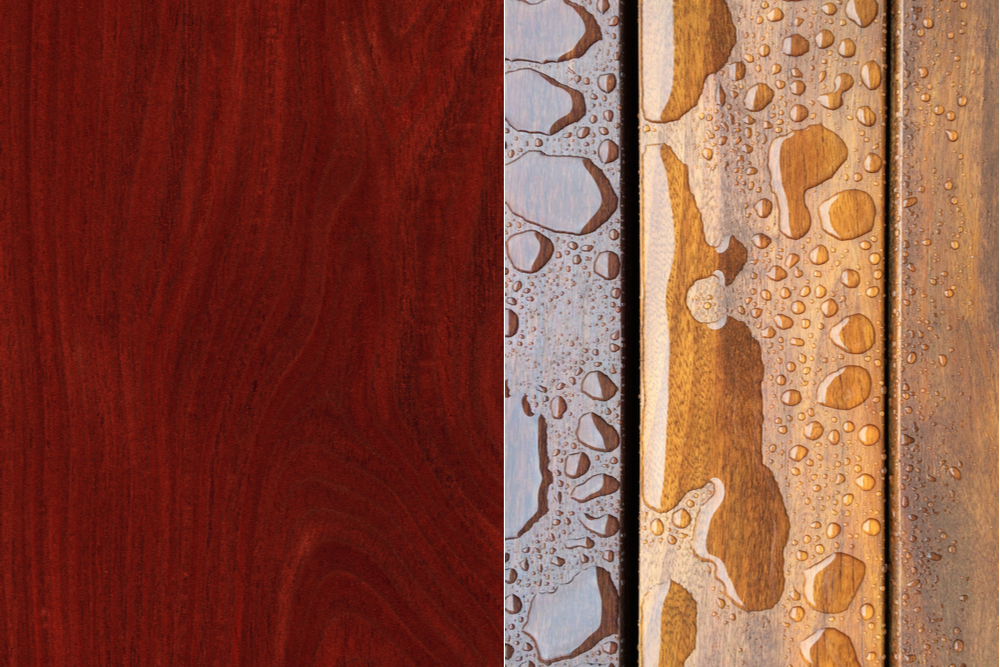In our previous post we presented a hypothetical Los Angeles homeowner with no financial brakes. Someone who decides to have a deck designed and built for his home, with money no object. This, to be sure, is a pretty rare client in real life. But such people do approach us. If you think about it, a deck is, in the end, a deck. Unless the design and appointments run wild into the ridiculous zone, a deck can only cost so much. Nobody’s going to specify golden champagne waterfalls, right? For many clients, though, tropical hardwood decking materials are the top-shelf choice. In our earlier post we looked at mahogany and teak. Let’s now go even more exotic, and encounter jarrah and cumaru tropical hardwood decking woods.
TROPICAL HARDWOOD DECKING WOODS: JARRAH
As we noted in the case of mahogany, there’s an issue of “off brand” jarrah. Real jarrah (Eucalyptus marginata) is native to the west of Australia. The off-brand is variously called South Atlantic Jarrah, Jarrahwood, and Masasaranduba. This tree is completely unrelated to the real Australian jarrah tree. Its wood looks like real jarrah, yes. Moreover, South Atlantic Jarrah is actually quite a bit harder than real jarrah. From the consumer’s point of view, nothing wrong with it, except that it’s not jarrah. That may matter to some buyers.
From the deck builder’s standpoint, though, there ‘s a practical difference. Real jarrah is hard. It takes a force of nearly 2,000 pounds to drive a steel test ball 0.444 inches in diameter halfway into a jarrah block. That’s with fresh jarrah wood. As jarrah wood ages, though, it becomes harder. So hard, in fact, that it’s almost impossible to work it with standard carpentry tools. And off-brand “jarrahwood” is 50% harder than that!
Jarrah wood’s reddish –brown color, and monumental texture are part of its appeal to discriminating buyers. The other part is, naturally, the rarity and cost.
THE HARDER HARDWOOD: CUMARU
Cumaru is a tree native to Central America and northern South America. The name “cumaru” is a nod to the indigenous Tupi language’s word for “tree”. Until recently, Venezuela was the biggest producer of cumaru trees. Following the instability and disruptions there, Nigeria may have popped into first place.
Cumaru decking has a lighter color than jarrah, with yellow undertones. The range is from light yellow to red-yellow. This wood is one of the very hardest of the hardwoods. It is five times harder, in fact, than redwood. One can expect long life from a cumaru deck, up to 50 years in milder climates like ours in the Los Angeles area. The wood’s hardness makes it a challenge to deck builders, but the glory of the finished project answers for those tasks.
Tropical hardwood decking is not for everyone. Our team at MG Construction & Decks is well acquainted with the whole spectrum of materials choices. We’ll gladly explain the differences in up-front and continuing costs, ROI at resale, and life expectancies. Tropical hardwood decking is always a bigger up front outlay. The ongoing maintenance expenses, though, may come as a pleasnt surprise. The bottom line with tropical hardwood, though, isn’t money. It’s sheer pleasure.
MG Construction & Decks offers several interior and exterior remodeling services in Los Angeles California. There is no project too small or too large. However, the majority of our focus has been focused on:

